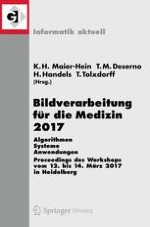2017 | Buch
Bildverarbeitung für die Medizin 2017
Algorithmen - Systeme - Anwendungen. Proceedings des Workshops vom 12. bis 14. März 2017 in Heidelberg
herausgegeben von: Klaus Hermann Maier-Hein, geb. Fritzsche, Thomas Martin Deserno, geb. Lehmann, Heinz Handels, Thomas Tolxdorff
Verlag: Springer Berlin Heidelberg
Buchreihe : Informatik aktuell
